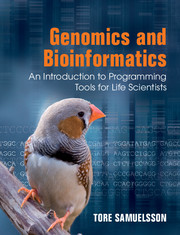Book contents
- Frontmatter
- Contents
- Preface
- Acknowledgements
- Design and conventions of this book
- 1 Introduction: working with the molecules of life in the computer
- 2 Gene technology: cutting DNA
- 3 Gene technology: knocking genes down
- 4 Gene technology: amplifying DNA
- 5 Human disease: when DNA sequences are toxic
- 6 Human disease: iron imbalance and the iron responsive element
- 7 Human disease: cancer as a result of aberrant proteins
- 8 Evolution: what makes us human?
- 9 Evolution: resolving a criminal case
- 10 Evolution: the sad case of the Tasmanian tiger
- 11 A function to every gene: termites, metagenomics and learning about the function of a sequence
- 12 A function to every gene: royal blood and order in the sequence universe
- 13 A function to every gene: a slimy molecule
- 14 Information resources: learning about flu viruses
- 15 Finding genes: going ashore at CpG islands
- 16 Finding genes: in the world of snurpsp
- 17 Finding genes: hunting for the distant RNA relatives
- 18 Personal genomes: the differences between you and me
- 19 Personal genomes: what’s in my genome?
- 20 Personal genomes: details of family genetics
- Appendix I Brief Unix reference
- Appendix II A selection of biological sequence analysis software
- Appendix III A short Perl reference
- Appendix IV A brief introduction to R
- Index
- References
1 - Introduction: working with the molecules of life in the computer
Published online by Cambridge University Press: 05 August 2012
- Frontmatter
- Contents
- Preface
- Acknowledgements
- Design and conventions of this book
- 1 Introduction: working with the molecules of life in the computer
- 2 Gene technology: cutting DNA
- 3 Gene technology: knocking genes down
- 4 Gene technology: amplifying DNA
- 5 Human disease: when DNA sequences are toxic
- 6 Human disease: iron imbalance and the iron responsive element
- 7 Human disease: cancer as a result of aberrant proteins
- 8 Evolution: what makes us human?
- 9 Evolution: resolving a criminal case
- 10 Evolution: the sad case of the Tasmanian tiger
- 11 A function to every gene: termites, metagenomics and learning about the function of a sequence
- 12 A function to every gene: royal blood and order in the sequence universe
- 13 A function to every gene: a slimy molecule
- 14 Information resources: learning about flu viruses
- 15 Finding genes: going ashore at CpG islands
- 16 Finding genes: in the world of snurpsp
- 17 Finding genes: hunting for the distant RNA relatives
- 18 Personal genomes: the differences between you and me
- 19 Personal genomes: what’s in my genome?
- 20 Personal genomes: details of family genetics
- Appendix I Brief Unix reference
- Appendix II A selection of biological sequence analysis software
- Appendix III A short Perl reference
- Appendix IV A brief introduction to R
- Index
- References
Summary
[Jim Kent] embarked on a four-week programming marathon, icing his wrists at night to prevent them from seizing up as he churned out computer code by day. His deadline was June 26, when the completion of the rough draft was to be announced.
(DNA: The Secret of Life, describing Jim Kent's efforts in the human genome sequencing project in 2000; Watson and Berry, 2003)It was a somewhat historic event when President Bill Clinton announced, on 26 June 2000, the completion of the first survey of the entire human genome. We were able for the first time to read all three billion letters of the human genetic make-up. This information was the ground-breaking result of the Human Genome Project. The success of this project relied on advanced technology, such as a number of experimental molecular biology methods. However, it also required a significant contribution from more theoretical disciplines such as computer science. Thus, in the final phase of the project, numerous pieces of information like those in a giant jigsaw puzzle needed to be appropriately combined. This step was critically dependent on programming efforts. Adding further tension to the programming exercises was the fact that a private company, Celera, was competing with the academic Human Genome Project. This competition was sometimes referred to as ‘the Genome War’ (Shreeve, 2004). While computationally talented people like Jim Kent ‘churned out computer code’, other gifted bioinformaticians, such as Gene Myers at Celera, worked on related jigsaw-puzzle problems. Ideally, scientists should not war against each other; however, there was an important conclusion from these projects in which important genetic information was generated: computing is an essential part of biological research.
Information
- Type
- Chapter
- Information
- Genomics and BioinformaticsAn Introduction to Programming Tools for Life Scientists, pp. 1 - 18Publisher: Cambridge University PressPrint publication year: 2012
